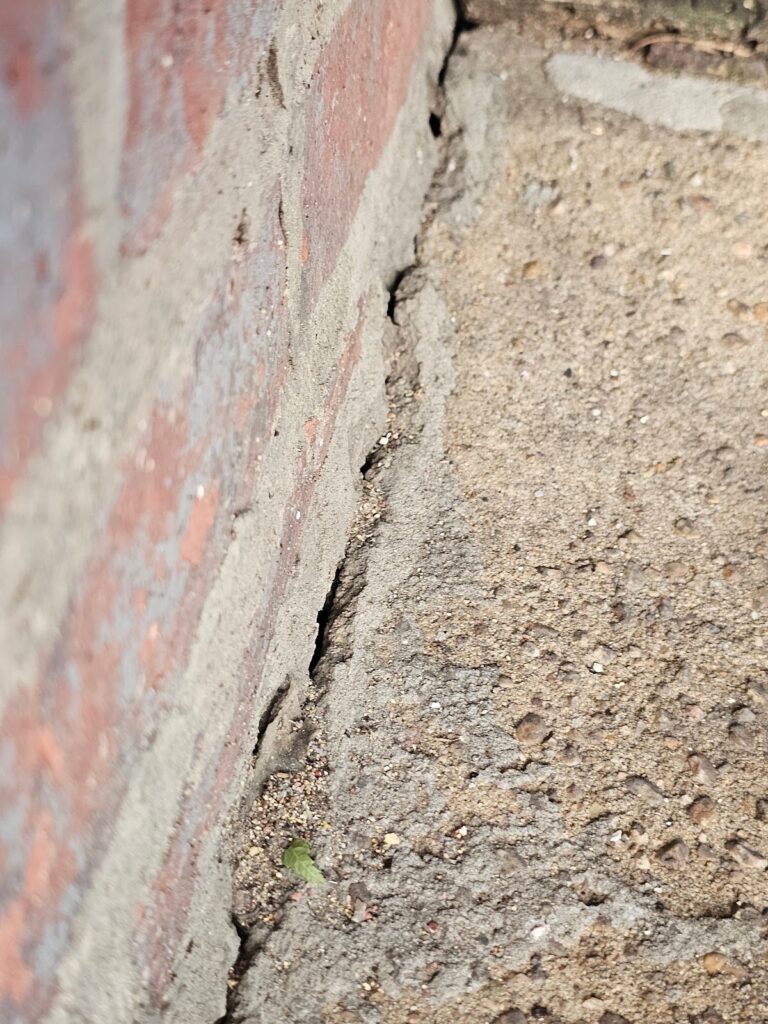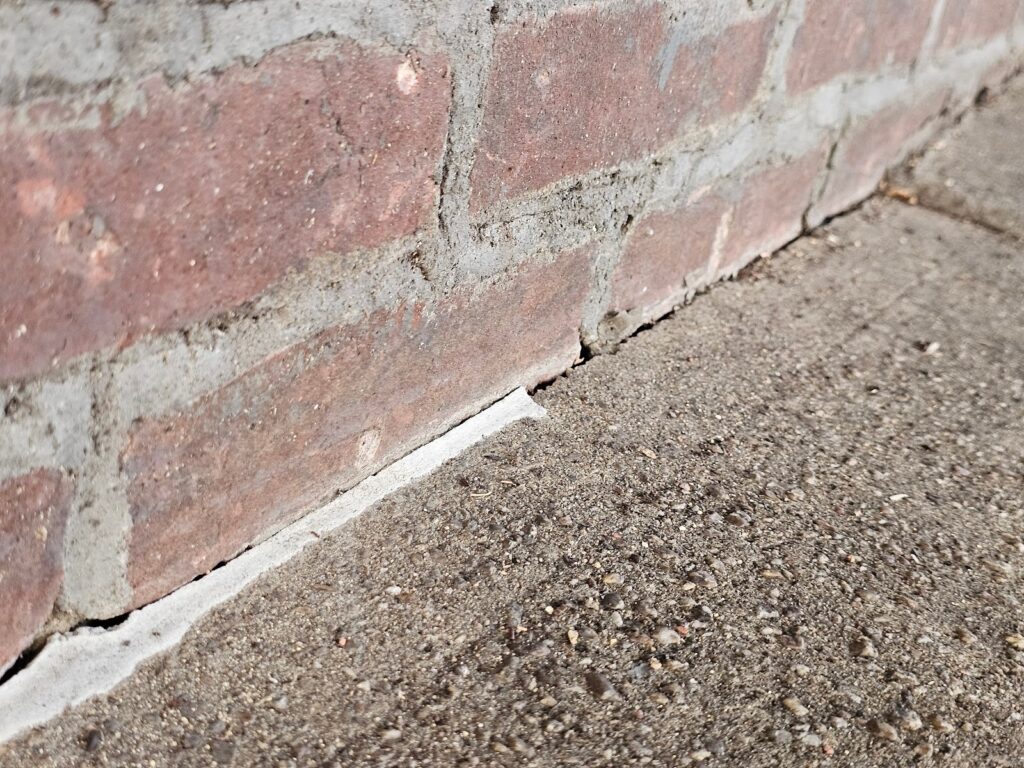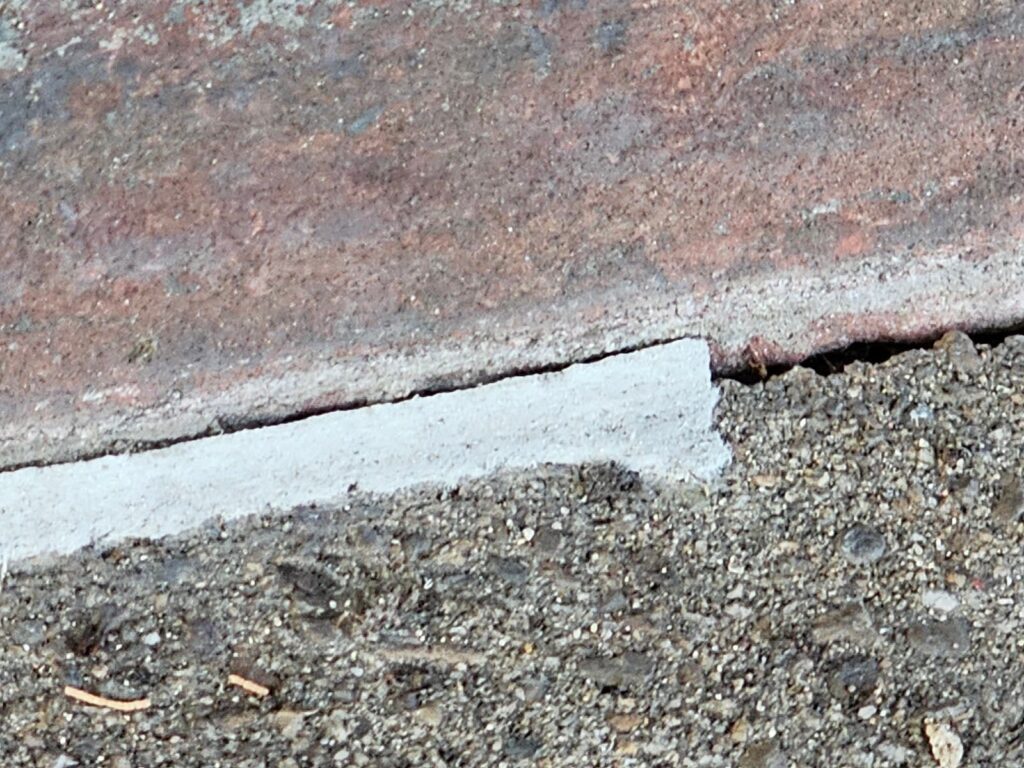Addressing Cracks Where Brick Wall Meets Paving
This past week, we looked at a particular type of paving next to a brick wall where the paving was separated from the brick wall with an intentional expansion joint. By comparison, today we’re going to look at similar types of pictures that are actually showing very different circumstances.
This issue, that we show here today, is about tge joint between a horizontal concrete paving, against the brick wall where no expansion joint was installed at all. Even though they didn’t install a cover expansion joint last week’s condition could be considered better than just installing the paving directly against the wall, they didn’t remove the excess amount of expansion board and they should have then filled that area with a polyurethane or similar type of elastomeric sealant to prevent water entry through the permeable material of the expansion joint.
In the picture below, this condition is different yet actually just as bad from a functional perspective, but even worse from an aesthetic perspective. An excessive expansion joint, even when it should have originally been cleaned up, trimmed back with a razor knife, and filled at the top with elastomeric sealant, even though left Incorrect and unfinished, can still be corrected.
Here though, as shown in the picture below where they have installed the concrete directly against the brick wall without even an expansion joint, the only way to repair the jagged edge of the fractured concrete is to replace the concrete, cut it so significantly that it cuts into the intended field area of the concrete, or apply a modified type of cementitious patch. None of these options are good options.
They’re all somewhat complicated, expensive, and have relatively high rates of probable failures within a relatively short periods of time. Those elements are relatively bad recipes for construction of new elements and or repair. Here though the problem goes right back to the time of original installation so the problem is not truly about repair, restoration and upkeep, it’s really about bad initial construction which highlights the importance and value of having a good contractor cares about details..

The picture above shows a type of problem that could have been easily avoided by simply installing an expansion joint between these two disparate materials.
The next picture below shows a different circumstance which is slightly better but still not correct. In the picture below, they installed the concrete directly against the face of the base of the brick wall, yet they did not leave any expansion joint or space to allow for expansion. Contraction isn’t really as much of a problem. Expansion happens naturally in cycles as the concrete warms. Just like the weather outside, even within the span of a typical day, temperatures fluctuate drastically sometimes.
As the temperatures warm up, the concrete also warms up (but still at a slower rate because concrete generally acts as a thermal sync which offsets the transfer of thermal energy) and eventually expands to the point that it puts an inordinate amount of pressure on nearby or adjacent elements such as the brick wall.Concrete would expand into the expansion joint and not cause any problem to the brick work. Yet in this case it cannot do that because the expansion joint has been omitted.
In the case of the concrete shown in the picture below since there is no expansion joint, the normal cyclical movement of the concrete pad puts problematic pressure against the brick wall which will lead to cracking and or deterioration of the brick work.

If you look closely, you can see that somebody has at least attempted to apply a sealant between the brick and the concrete. The concrete is a moderate gray and the brick has a moderate mortar joint with a red-faced brick. If they had selected the caulking with a little bit more care, they could have at least selected a color that blended better between these two disparate types of surfaces. Instead they picked something totally random that matches none of the surroundings.

Our company, Dupont Tuckpointing and Masonry, specializes in masonry restoration, historic brick repointing, and tuckpointing services in the Washington D.C. area. These buildings are uniquely historic, and their preservation requires skilled masons who are technically trained in the best practices and knowledge of proper restoration techniques.
We understand the significance of maintaining the architectural integrity of these historic structures, and our team of experienced professionals is dedicated to delivering exceptional craftsmanship. Whether you require masonry restoration, tuckpointing, or brick repointing services, we are here to help.
At Dupont Tuckpointing and Masonry, we take pride in our work and strive to ensure that every project is executed with the utmost care and attention to detail. We are committed to preserving the rich heritage of Washington D.C.’s built environment for generations to come.
If you have any questions or needs regarding masonry restoration, historic brick repointing, or tuckpointing services, please do not hesitate to reach out to us. We would be delighted to assist you and provide you with the expertise and quality workmanship that your historic property deserves.
You can reach us by telephone at (202) 796-7644 and you can reach us by email from the contact form on our website at https://duponttuckpointingmasonrydc.com/contact-us/.




